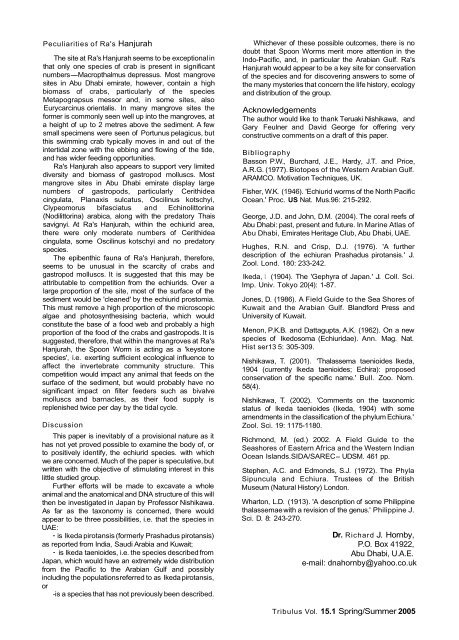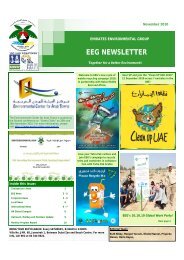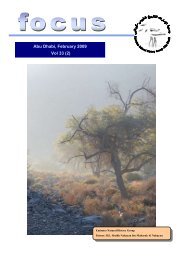Oman (Lepidoptera: Pieridae) - Al Ain Chapter, Emirates Natural ...
Oman (Lepidoptera: Pieridae) - Al Ain Chapter, Emirates Natural ...
Oman (Lepidoptera: Pieridae) - Al Ain Chapter, Emirates Natural ...
You also want an ePaper? Increase the reach of your titles
YUMPU automatically turns print PDFs into web optimized ePapers that Google loves.
Peculiarities of Ra's Hanjurah<br />
The site at Ra's Hanjurah seems to be exceptional in<br />
that only one species of crab is present in significant<br />
numbers-Macropthalmus depressus. Most mangrove<br />
sites in Abu Dhabi emirate, however, contain a high<br />
biomass of crabs, particularly of the species<br />
Metapograpsus messor and, in some sites, also<br />
Eurycarcinus orientalis. In many mangrove sites the<br />
former is commonly seen well up into the mangroves, at<br />
a height of up to 2 metres above the sediment. A few<br />
small specimens were seen of Portunus pelagicus, but<br />
this swimming crab typically moves in and out of the<br />
intertidal zone with the ebbing and flowing of the tide,<br />
and has wider feeding opportunities.<br />
Ra's Hanjurah also appears to support very limited<br />
diversity and biomass of gastropod molluscs. Most<br />
mangrove sites in Abu Dhabi emirate display large<br />
numbers of gastropods, particularly Cerithidea<br />
cingulata, Planaxis sulcatus, Oscilinus kotschyi,<br />
Clypeomorus bifasciatus and Echinolittorina<br />
(Nodilittorina) arabica, along with the predatory Thais<br />
savignyi. At Ra's Hanjurah, within the echiurid area,<br />
there were only moderate numbers of Cerithidea<br />
cingulata, some Oscilinus kotschyi and no predatory<br />
species.<br />
The epibenthic fauna of Ra's Hanjurah, therefore,<br />
seems to be unusual in the scarcity of crabs and<br />
gastropod molluscs. It is suggested that this may be<br />
attributable to competition from the echiurids. Over a<br />
large proportion of the site, most of the surface of the<br />
sediment would be 'cleaned' by the echiurid prostomia.<br />
This must remove a high proportion of the microscopic<br />
algae and photosynthesising bacteria, which would<br />
constitute the base of a food web and probably a high<br />
proportion of the food of the crabs and gastropods. It is<br />
suggested, therefore, that within the mangroves at Ra's<br />
Hanjurah, the Spoon Worm is acting as a 'keystone<br />
species', i.e. exerting sufficient ecological influence to<br />
affect the invertebrate community structure. This<br />
competition would impact any animal that feeds on the<br />
surface of the sediment, but would probably have no<br />
significant impact on filter feeders such as bivalve<br />
molluscs and barnacles, as their food supply is<br />
replenished twice per day by the tidal cycle.<br />
Discussion<br />
This paper is inevitably of a provisional nature as it<br />
has not yet proved possible to examine the body of, or<br />
to positively identify, the echiurid species. with which<br />
we are concerned. Much of the paper is speculative, but<br />
written with the objective of stimulating interest in this<br />
little studied group.<br />
Further efforts will be made to excavate a whole<br />
animal and the anatomical and DNA structure of this will<br />
then be investigated in Japan by Professor Nishikawa.<br />
As far as the taxonomy is concerned, there would<br />
appear to be three possibilities, i.e. that the species in<br />
UAE:<br />
- is lkeda pirotansis (formerly Prashadus pirotansis)<br />
as reported from India, Saudi Arabia and Kuwait;<br />
- is lkeda taenioides, i.e. the species described from<br />
Japan, which would have an extremely wide distribution<br />
from the Pacific to the Arabian Gulf and possibly<br />
including the populations referred to as Ikeda pirotansis,<br />
or<br />
-is a species that has not previously been described.<br />
Whichever of these possible outcomes, there is no<br />
doubt that Spoon Worms merit more attention in the<br />
Indo-Pacific, and, in particular the Arabian Gulf. Ra's<br />
Hanjurah would appear to be a key site for conservation<br />
of the species and for discovering answers to some of<br />
the many mysteries that concern the life history, ecology<br />
and distribution of the group.<br />
Acknowledgements<br />
The author would like to thank Teruaki Nishikawa, and<br />
Gary Feulner and David George for offering very<br />
constructive comments on a draft of this paper.<br />
Bibliography<br />
Basson P.W., Burchard, J.E., Hardy, J.T. and Price,<br />
A.R.G. (1977). Biotopes of the Western Arabian Gulf.<br />
ARAMCO. Motivation Techniques, UK.<br />
Fisher, W.K. (1 946). 'Echiurid worms of the North Pacific<br />
Ocean.' Proc. US Nat. Mus.96: 21 5-292.<br />
George, J.D. and John, D.M. (2004). The coral reefs of<br />
Abu Dhabi: past, present and future. In Marine Atlas of<br />
Abu Dhabi, <strong>Emirates</strong> Heritage Club, Abu Dhabi, UAE.<br />
Hughes, R.N. and Crisp, D.J. (1976). 'A further<br />
description of the echiuran Prashadus pirotansis.' J.<br />
Zool. Lond. 180: 233-242.<br />
Ikeda, I. (1904). The 'Gephyra of Japan.' J. Coll. Sci.<br />
Imp. Univ. Tokyo 20(4): 1-87.<br />
Jones, D. (1 986). A Field Guide to the Sea Shores of<br />
Kuwait and the Arabian Gulf. Blandford Press and<br />
University of Kuwait.<br />
Menon, P.K.B. and Dattagupta, A.K. (1962). On a new<br />
species of Ikedosoma (Echiuridae). Ann. Mag. Nat.<br />
Hist ser13 5: 305-309.<br />
Nishikawa, T. (2001 ). 'Thalassema taenioides I keda,<br />
1904 (currently lkeda taenioides; Echira): proposed<br />
conservation of the specific name.' Bull. Zoo. Nom.<br />
58(4).<br />
Nishikawa, T. (2002). 'Comments on the taxonomic<br />
status of lkeda taenioides (Ikeda, 1904) with some<br />
amendments in the classification of the phylum Echiura.'<br />
Zool. Sci. 19: 1175-1180.<br />
Richmond, M. (ed.) 2002. A Field Guide to the<br />
Seashores of Eastern Africa and the Western Indian<br />
Ocean Islands.SIDA/SAREC - UDSM. 461 pp.<br />
Stephen, A.C. and Edmonds, S.J. (1972). The Phyla<br />
Sipuncula and Echiura. Trustees of the British<br />
Museum (<strong>Natural</strong> History) London.<br />
Wharton, L.D. (1913). 'A description of some Philippine<br />
thalassemae with a revision of the genus.' Philippine J.<br />
Sci. D. 8: 243-270.<br />
Dr. Richard J. Hornby,<br />
P.O. Box 41 922,<br />
Abu Dhabi, U.A.E.<br />
e-mail: dnahornby@yahoo.co.uk<br />
Tribulus Vol. 15.1 Spring/Summer 2005




